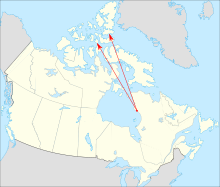
The High Arctic relocation (French: délocalisation du Haut-Arctique, Inuktitut: ᖁᑦᑎᒃᑐᒥᐅᑦᑕ ᓅᑕᐅᓂᖏᑦ, romanized: Quttiktumut nuutauningit[1]) took place during the Cold War in the 1950s, when 92 Inuit were moved by the Government of Canada under Liberal Prime Minister Louis St. Laurent to the High Arctic.[2][3]
The relocation has been a source of controversy: on one hand being described as a humanitarian gesture to save the lives of starving indigenous people and enable them to continue a subsistence lifestyle; and on the other hand, said to be a forced migration instigated by the federal government to assert its sovereignty[clarification needed] in the Far North by the use of "human flagpoles",[4] in light of both the Cold War and the disputed territorial claims to the Canadian Arctic Archipelago. Both sides acknowledge that the relocated Inuit were not given sufficient support to prevent extreme privation during their first years after the move.
- ^ Makkik, Romani (Fall 2009). "The High Arctic Relocations" (PDF). Naniiliqpita. pp. 7–11.
- ^ Dussault, René; Erasmus, George (1994). The High Arctic Relocation: A Report on the 1953–55 Relocation (PDF) (Report). Royal Commission on Aboriginal Peoples. ISBN 0-660-15544-3.
- ^ Porteous, J. Douglas; Smith, Sandra E (2001). Domicide: The Global Destruction of Home. McGill-Queen's University Press. pp. 102–103. ISBN 978-0-7735-2258-9.
- ^ Cite error: The named reference
Popewas invoked but never defined (see the help page).